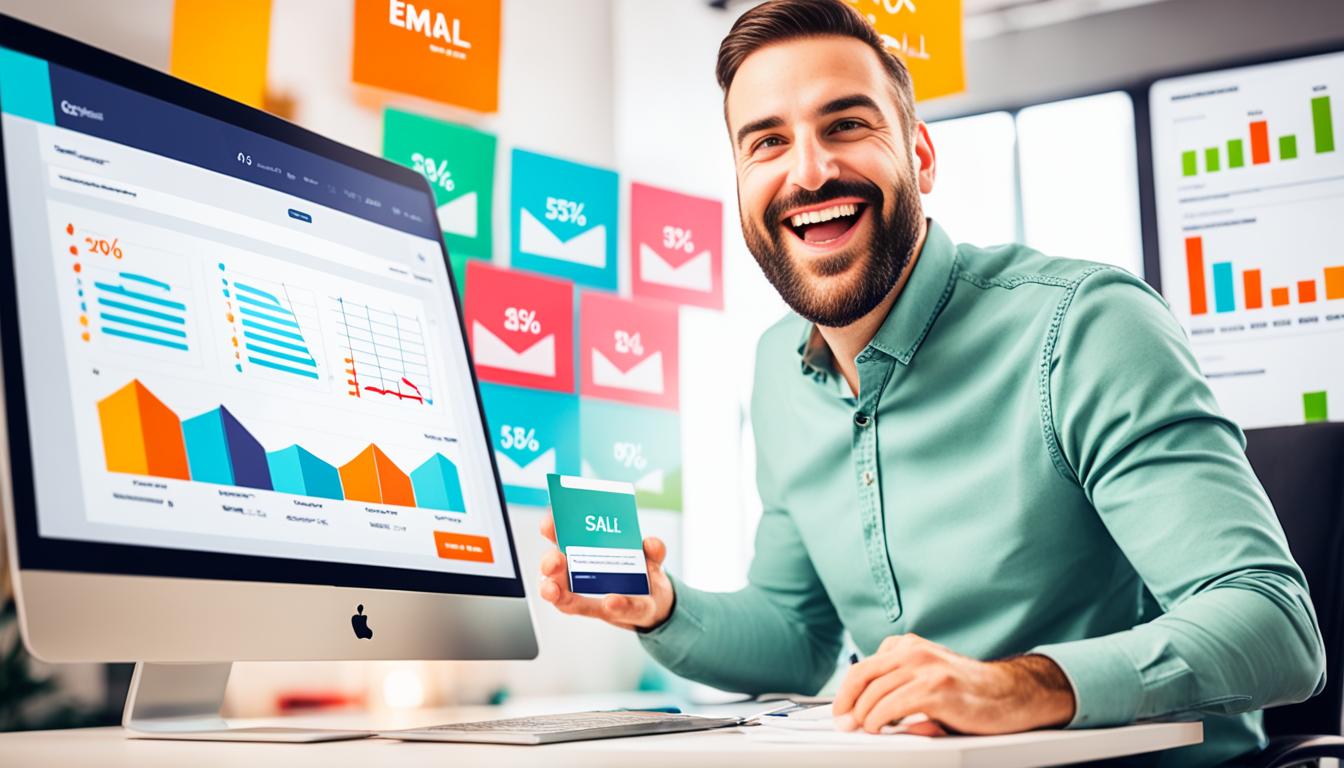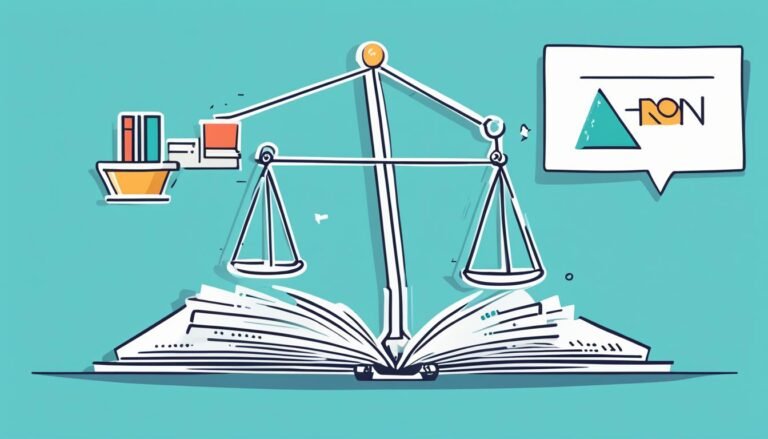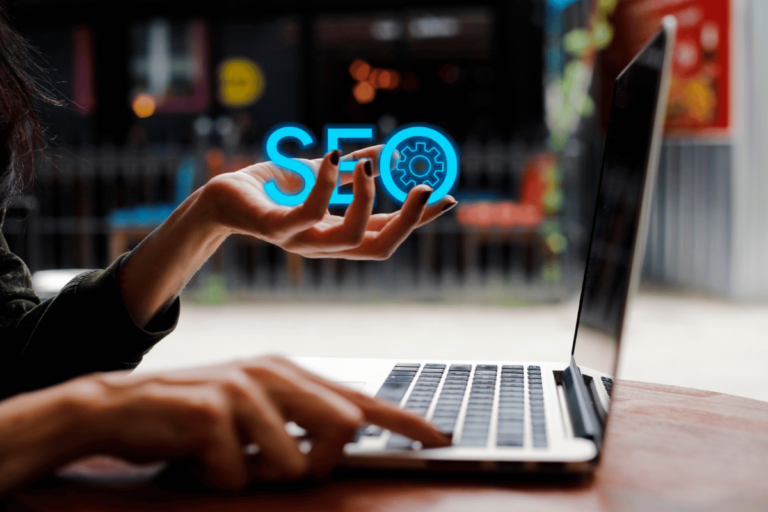Email Campaigns for E-commerce Businesses
Imagine finding cool running shoes on Nike’s online store. You add them to your cart but don’t buy them right away. Soon, an email arrives reminding you about the shoes. It might even offer a discount. This simple email can be the push you need to buy, showing how key emails are for online stores.
Email marketing is a crucial part of online business success. Studies prove that emails, particularly the automatic ones, do wonders. They not only make more money but also keep customers engaged and happy.
Now, think of the effect of a welcome email from Judy or YETI. It catches your eye and gets a 50% open rate, beating other promotional emails easily. Let’s talk about abandoned carts next. 70% of people who put things in their carts don’t buy them. But, smart emails about those items can win back sales. Such emails have a 45% open rate. Plus, half of the people who click buy the item.
Emails work so well because they’re personal and timely. Marketers see a big increase in attention with customized emails. Almost all professionals think this type of email approach is a must. Personal emails bring in most of the money for businesses. Even sending emails to reconnect with old customers has a high chance of success.
Key Takeaways
- Welcome emails have a 50% open rate and drive three times the transaction and revenue compared to other promotional mails.
- 70% of online shoppers abandon their carts, but targeted emails recover a significant portion.
- Browse abandonment emails have significantly higher open and click-through rates than traditional emails.
- Personalization is crucial, with 94% of professionals agreeing on its importance for meeting marketing objectives.
- Segmented and targeted emails can generate 58% of all e-commerce revenue.
Introduction to Email Marketing for E-commerce
Email marketing is vital for e-commerce, letting businesses tell subscribers about new stuff. It keeps customers involved and helps turn leads into long-lasting relationships.
Personalized marketing is big, making email strategies effective for engaging people. Let’s dive into why email marketing is key for e-commerce.
What Is Email Marketing?
Email marketing means sending commercial posts to many people via email. It’s about reaching out to new customers, keeping the relationship with current ones, and making leads feel special.
Studies show email marketing is a great investment in e-commerce. It can earn businesses $44.25 for every dollar spent. Also, smart tech in these emails can make the customer’s experience better.
Why Email Marketing Matters for E-commerce
Email marketing is crucial for e-commerce because it:
- Keeps Customers: It’s cheaper to keep old customers happy than to find new ones. Emails help with that.
- Brings Fast Results: Quick sales and traffic can come from special deals in emails.
- Makes it Personal: When you tailor emails to people’s tastes, they’re more likely to buy.
- Reminder to Customers: Emails that remind customers you’re there can help bring them back.
- Reaches Many People: Email is a common way to talk to people, especially on mobile. Nearly half of all emails are checked on mobile.
Here’s some key data showing why email marketing is a big deal for e-commerce:
| Statistic | Value |
|---|---|
| Average ROI for Email Marketing | $42 for every $1 spent |
| Customer Spend Increase with Marketing Emails | 138% |
| Mobile Email Users Worldwide | 897 million |
| Emails Opened on Mobile Devices | 48% |
Using smart email strategies helps e-commerce businesses grow. It builds trust and keeps customers happy, leading to a loyal fan base.
The Power of Welcome Email Series
Welcome emails are key for online shops. They get opened 55.61% of the time on average. These emails help start good relationships with new people who join your mailing list. They lead to first sales and keep subscribers interested. Let’s look at how to make the best welcome emails. We’ll also see examples and tips for getting the most out of them.
Crafting the Perfect Welcome Email
To make a great welcome email, mix in personal touches, clear steps to follow, and sending it at just the right time. Here’s what you need:
- Personalization: Make the email personal by using the subscriber’s name in the subject and body.
- Clear CTAs: Tell subscribers what to do next in simple terms.
- Immediate Delivery: Don’t wait. Send the email as soon as someone signs up.
- Brand Introduction: Introduce your brand by sharing its story, values, and products.
- Incentives: A discount or free shipping tempts new subscribers to buy for the first time.
Examples of Effective Welcome Emails
Some brands simply nail their welcome emails. Take Pandora, for example. They welcome new subscribers with a 15% discount and introduce their brand well. Levi’s takes it further with personalized product suggestions based on what the subscriber likes. This makes the welcome personal and engaging.
Then there’s PajamaGram. They follow up with tailored product ideas 24-48 hours later. This keeps the conversation going.
Maximizing Engagement with Welcome Emails
The aim of welcome emails is to get new subscribers to act and start shopping. Here’s how to do it well:
- Automation: Use automated workflows to send timely, relevant emails.
- Interactive Elements: Consider using AMP emails and forms to make CTAs fun and clickable.
- Visual Appeal: Pretty up your emails with great pictures and a design that works on phones.
- Social Proof: Add links to your social media to show your brand is trusted.
- Feedback: Use surveys to learn what your customers like and what they want more of.
Welcome emails can boost first-time sales and build lasting bonds with customers. Used right, they’re powerful tools for any brand.
Boost Sales with Cart Abandonment Emails
Cart abandonment is a big issue in online selling, affecting about 70% of shoppers. But, sending reminders can win back these lost sales and customer interest.
Why Shoppers Abandon Carts
There are many reasons why people leave their carts behind. Distractions, high costs, surprise fees, and quick choices play a big part. Knowing these, sellers can better approach customers, addressing their needs in emails.
Strategies for Successful Cart Abandonment Emails
Eye-catching subject lines are the first step in winning customers back. Email text should be convincing, adding powerful prompts to buy. Using pictures of left-behind items can also grab attention.
Remarketing ads and popups can also work well, as do special offers. Customized emails are more likely to be opened, giving a better chance to make a sale. Testing different email styles helps find the best options for click-through and open rates.
Metrics are key in optimizing emails. Tracking your success, you can learn what works best. A series of emails can remind clients, share new offers, and keep them interested.
Case Studies: High-Converting Cart Abandonment Campaigns
Many top brands have used emails to bring customers back. YETI, for example, sends emails that create urgency. This method inspires customers to check out before it’s too late.
Companies like Dyson and Virgin Atlantic send beautiful, personalized emails. These encourage action, driving sales. Their success shows the power of effective email design and strategy.
In conclusion, cart abandonment emails can turn almost-lost sales into wins. The key is making emails personal, engaging, and well-tracked. This way, sellers can use emails smartly to boost their business.
Revitalize Your Campaigns with Browse Abandonment Emails
E-commerce businesses face a big issue with customers who browse but don’t buy. This behavior, known as browse abandonment, leads to lost sales. In the US, on mobile phones, 84% of people left without buying in the second quarter of 2022. This shows we need smart solutions.
Adding browse abandonment emails to your marketing can increase open rates by 80%. These emails remind customers of things they liked or suggest other products they might enjoy. This lets businesses tackle reasons for not buying and get customers interested again.
To make these emails even more effective, use reminders and product showcases. You can also add limited-time discounts to boost sales and keep customers loyal. Sharing feedback from others and their positive stories can help too. This shows your product is valuable and builds a good image for your brand.
By using browse abandonment emails, e-commerce businesses can make 20-30% more revenue. Making the messages personal makes customers feel special, which can increase sales. Using dynamic content grabs attention and can prompt people to buy.
| Email Type | Effectiveness |
|---|---|
| Reminder and Product Showcase | Recover lost revenue |
| Limited-time Discount | Enhance conversion rates and loyalty |
| Social Proof and Testimonial | Persuade doubters, reinforce product value |
Using browse abandonment emails is more than reminding customers. It’s about reigniting their buying interest. By using personalized, dynamic content, you can turn casual browsers into committed customers. This shows how important smart email marketing is for e-commerce.
Engaging Your Customers with Post-Purchase Follow-ups
Sending a post-purchase follow-up is key in getting customers to come back. It also makes them feel valued. Post-purchase emails often have higher open rates than regular emails.
Companies like ILIA use post-purchase emails to share helpful info. This keeps customers connected. Post-purchase emails do well in some industries, like automotive, sporting goods, and hardware. Clearly, they boost sales.
Importance of Post-Purchase Follow-ups
A good post-purchase plan includes different emails. These can include order confirmations and how-to emails. Emails sent at the right time help customers use their products better.
- Order Confirmation
- Shipping Notification
- How-to Information
- Reminder Emails
- Survey Emails
- User-Generated Content Emails
- Upsell/Cross-sell Emails
Surveys and feedback can make a big difference. They boost satisfaction and brand image. Well-done post-purchase emails increase how many people respond. This improves customer value over time.
Creating Educational Emails for Product Use
Educational emails are very effective for post-purchase follow-ups. They help customers know more about their products. Brands should aim to give clear and useful tips. This keeps customers happy and engaged.
These emails show the brand cares. Including user content makes customers feel part of a community. It boosts the brand’s trustworthiness.
Email Campaigns for E-commerce Businesses
Email campaigns are key for any e-commerce business today. They help launch new items, share seasonal deals, and thank buyers. These emails lead to 59% of purchases and get a $44 return for every $1 spent.
Introduction
With over 12 million online shops, the challenge is tough. Yet, email campaigns are a top choice for connecting with customers, as 70% prefer emails from brands. Smart use of emails can boost interest, increase sales, and build trust.
Core Strategies
Emails work best when they meet customers where they are in their shopping journey:
- Welcome Emails: They can spike engagement by 500% and are opened by more than half of the users.
- Cart Abandonment Emails: Sometimes, when people leave their carts, a reminder works. These emails get opened 40% of the time and nearly 30% lead to a click back to the website.
- Re-engagement Emails: Brands like Netflix send these emails to win back users who’ve gone silent. It’s a clever move to keep in touch with everyone.
- Upsell and Cross-sell Emails: Recommending related items can add value for customers and keep their loyalty.
- Post-Purchase Follow-ups: These emails show you care and offer help on using the products. They’re about more than just saying thanks.
Examples and Case Studies
- Casper: Lists of top-selling items and reminders to restock bring users back. It’s an effective way to keep them engaged.
- Sephora: They use personal tips and special deals to bring shoppers back. These tactics make customers feel special and keep them coming back.
| Campaign Type | Brand | Impact |
|---|---|---|
| Curated Bestsellers | Casper | Increased engagement rates |
| Personalized Product Replenishments | Casper | Improved customer retention |
| Personalized Recommendations | Sephora | Enhanced repeat purchases |
| Exclusive Offers | Sephora | Increased shopping frequency |
Leveraging Personalized Product Recommendations
Personalized product recommendations make emails more powerful. They help businesses and customers connect better. E-commerce companies use them to make more sales and keep customers interested.
Personalization Techniques in Email Marketing
Businesses use different techniques to make emails feel more personal. They look at what you’ve seen online and use high-tech math to guess what you might like. For example, on Amazon, they show what others have bought next to what you’re looking at. This creates an engaging experience that customers like.
Stitch Fix goes further. They pick outfits for you based on what you’ve liked and bought before. It’s like having a personal shopper in your inbox.
Impact of Personalized Recommendations on Sales
Personalized emails are huge for sales, making up over half of revenue from emails. They keep over half of customers coming back. Sephora uses them to sell more beauty products. They look at your skin type and what you like to offer the best choices.
Netflix also uses this idea. They suggest movies and shows you might like, which makes watching more fun. This keeps people choosing Netflix over other services.
Tools and Technologies for Personalization
There are lots of cool tools that personalize marketing. AI is a big one here. It helps businesses like Sephora suggest the best products by looking at your past choices. This kind of tech makes shopping feel as if it’s made just for you.
Then there’s Loup, making shopping more personal through live videos. This new field, known as One-to-Many Live Shopping, is another way to make the shopping journey exciting and unique.
Below is a comparison of successful brands utilizing personalized product recommendations:
| Brand | Personalization Strategy | Outcome |
|---|---|---|
| Amazon | “Customers who bought this also bought” feature | Increased sales and customer retention |
| Sephora | Personalized beauty recommendations | Higher sales and customer loyalty |
| Netflix | Personalized movie and TV show recommendations | Enhanced customer engagement |
| Stitch Fix | Customized outfit recommendations | Improved customer satisfaction |
| Nike | Personalized product design options | Increased sense of ownership and loyalty |
Using personalized recommendations helps companies make more sales. It also makes customers trust and enjoy shopping with them. In today’s market, this personal touch is key to success for any online store.
Using Subscriber Segmentation for Targeted Campaigns
Subscriber segmentation is essential in targeted email marketing. It groups your audience by their behaviors, who they are, or what they’ve bought. This means hitting the mark with your messages.
About 82% of marketers saw more people opening their emails when they customized messages. This proves how making your campaigns relevant boosts success.
Using tools for automated email marketing can make life easier for most workers. These help make your strategies work better. For example, about 77% of marketers noticed more people engaging with their emails last year.
And by using automated A/B testing, you can find out what works best. This way, you keep improving your marketing with the best tactics.
For online shops, sorting people by where they live, who they are, or what they do can make campaigns better. This lets you know which product might be loved more in one area compared to another. So, you can send out emails about these products to the right people.
This approach ensures customers see what really interests them. It’s great for keeping customers coming back and increasing sales. Sales could jump to $11 billion by 2023 using these smart tactics.
Creating customer personas and analyzing the sales funnel can also be key. This way, online shops learn what each group wants. The result? Messages that really hit home. Whether getting back those almost sales or suggesting items just for you, it’s all about giving a great customer experience.
FAQ
What is email marketing?
Why does email marketing matter for e-commerce?
How do I craft the perfect welcome email?
Can you provide examples of effective welcome emails?
How can I maximize engagement with welcome emails?
Why do shoppers abandon carts?
What are some successful strategies for cart abandonment emails?
Can you share high-converting cart abandonment campaigns?
What are browse abandonment emails and how do they work?
Why is it important to send post-purchase follow-ups?
How can I create educational emails about product use?
What are the core strategies for e-commerce email campaigns?
Can you provide examples and case studies of successful email campaigns?
What are some personalization techniques in email marketing?
How do personalized recommendations impact sales?
What tools and technologies can help with email personalization?
What is subscriber segmentation and why is it important?
Source Links
- 21 Email Marketing Campaigns Every Ecommerce Store Needs – Email Mastery
- 11 Must-Have E-Commerce Email Marketing Campaigns (2024)
- 18 E-Commerce Email Marketing Examples of Money-Making Campaigns – MailerLite
- eCommerce email marketing: A beginner’s guide | Zapier
- An Introduction to Email Marketing for Ecommerce
- Introduction to Ecommerce Email Marketing: Strategies & Best Practices
- Welcome Email Series for E-commerce and D2C Brands
- 15 Incredible Examples of Welcome Emails (eCommerce)
- Welcome emails: types, best practices and examples – Klaviyo
- Blog | Debutify
- Abandoned Cart Emails: Best Practices + How to Automate
- The 16 Best Abandoned Cart Emails To Win Back Customers
- Revive Your Revenue: Inspiring Examples Of Abandoned Cart Email Templates
- "Revive Sales Using Abandoned Cart Emails"
- Elevate Your Digital Store’s Success – Favoured.
- Post-purchase email guide: examples + expert advice | Klaviyo
- Post Purchase Emails: 9 Examples and Tips For Your Business (2024) – Shopify
- Using Post-Purchase Emails to Improve Customer Loyalty | Mailchimp
- 15 Effective Email Marketing Campaigns for Ecommerce Store | Sender
- 14 E-Commerce Email Marketing Tips To Grow Your Business
- eCommerce Email Marketing: 10 Types of Emails (+ 6 Tips)
- 5 Personalized Service Examples And How They Can Boost Your E-commerce Business
- Personalized marketing for ecommerce: strategies and success stories
- The Value of Personalized Product Recommendations in Ecommerce
- Email Marketing Best Practices: Personalization, Segmentation and Automation
- Why Email Segmentation Matters For Campaigns | Mailchimp
- 9 Customer Segmentation Examples for E-Commerce Brands






